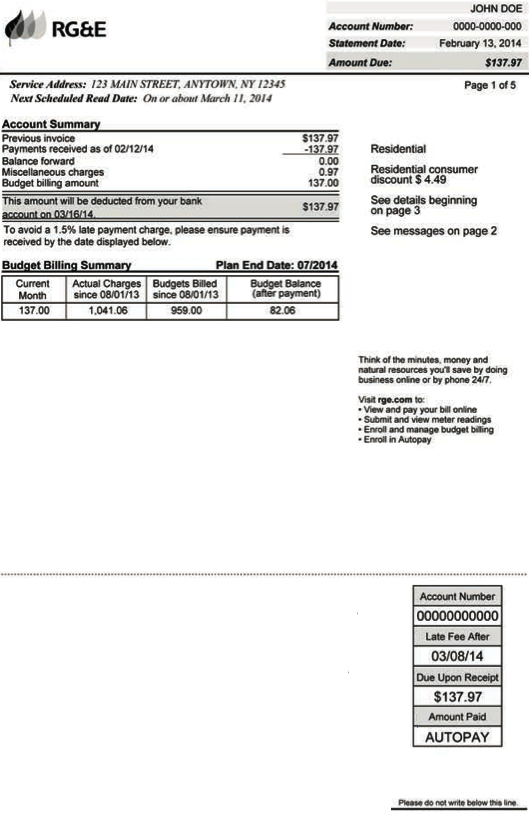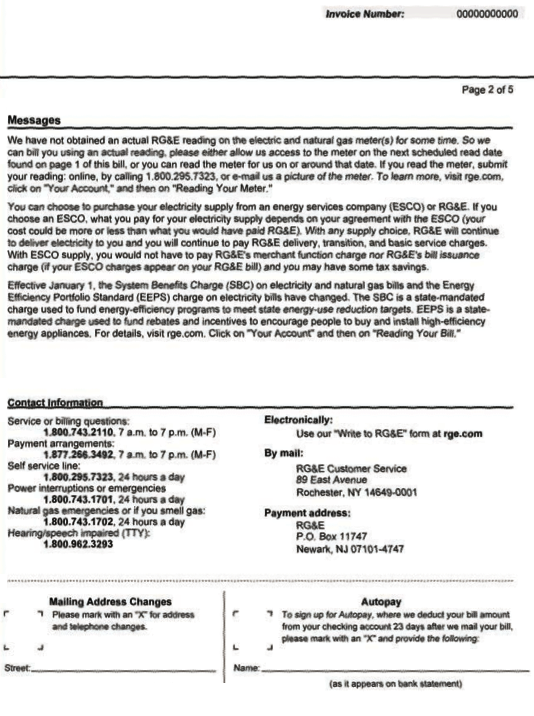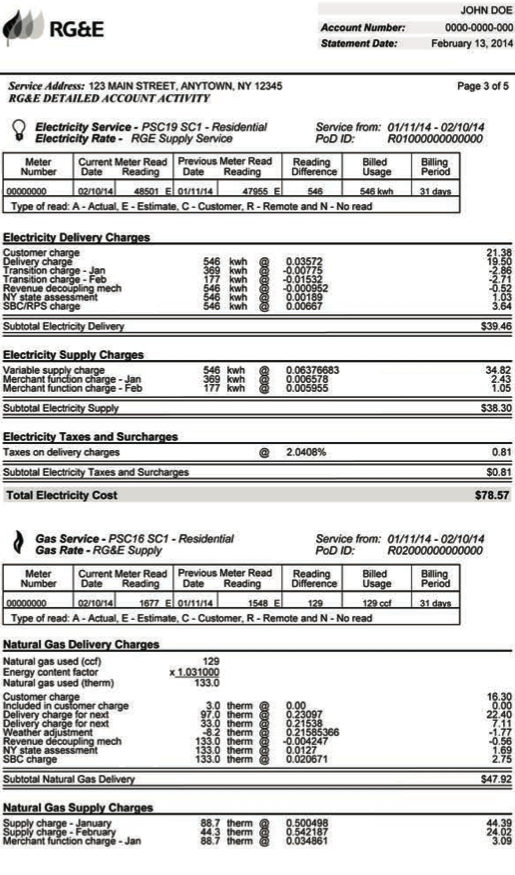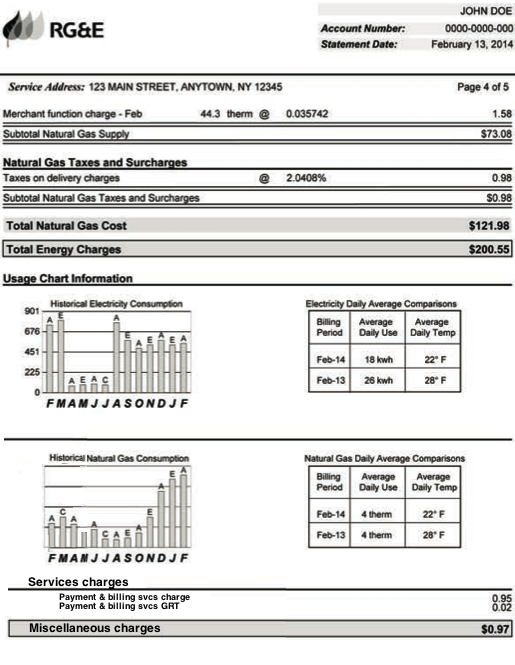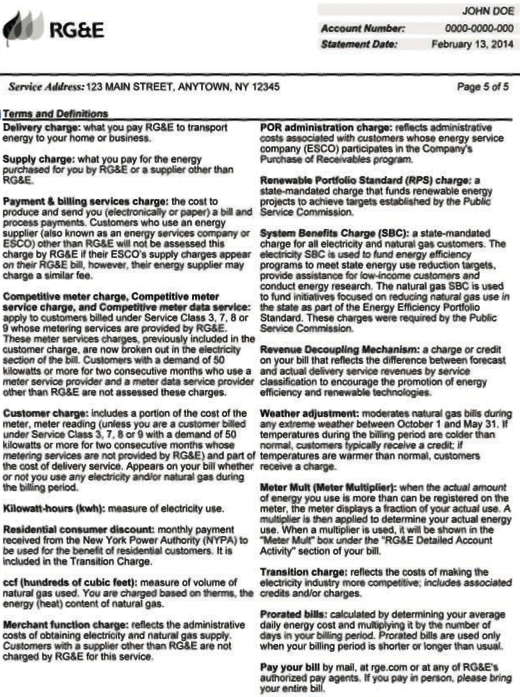Understanding Your Bill with RG&E in New York State
Here we describe a typical RG&E bill, giving a definition of each term and its reason for being in your bill.
Save Money With a Lower Rate!Customers in the RG&E service area can choose their energy supplier. Alternate suppliers can offer good deals and environmentally-friendly energy options. To learn more about energy supply options in your area, check out our pages on energy in New York, or call us directly at phone currently not available to find the best rates in your area.
Example of a 2014 RG&E bill - page 1
Account information
Basic information: Name, account number, statement date, amount due.
Account summary
- previous invoice: Amount to be paid on the previous bill.
- Payments received: Payments the customer made to RG&E for the previous bill. If you have paid your bill correctly, this amount should be equal to the previous invoice.
- Balance forward: any non-paid amount is forwarded to the next bill.
- Miscellaneous Charges: These are described in more detail on Page 4 of this exmaple bill.
- Budget billing amount: total amount of charges to be paid (apart from the miscellaneous charges).
- This amount will be deducted from you bank account on 03/16/14: total bill to pay.
- 1.5% late payment charge: since the statement was issued on February 21st, and you must pay the bill before March 16th, this leaves you around 3 weeks to pay your bill, or you will be charged an extra 1.5% on your outstanding balance. This does not include the late payment fees for supply in case you are signed up with an alternate supplier (ESCO).
Budget billing summary
Budget billing is a program you can enroll in to spread out your bill payments. RG&E will calculate your bill for the whole year based on the previous year's usage of electricity/gas. Your bill for the whole year will be divided up into 12 months and a bill will be sent to you every month. Every 3 months, your usage will be reevaluated, and the remaining monthly bills to be paid will be accordingly updated with the new calculated monthly payment amount. If there is any extra payment to be made at the end of the year, an extra bill will be issued with the extra amount to be paid by you. If you have overpaid, you will refunded on your last bill. Each bill will contain a table as the one here shown:
- Current Month: Shows how much you must pay for this bill.
- Actual Charges: Corresponds to the amount of usage that has been used since being on the budget. It is what you should be billed if you weren’t on the program.
- Budgets Billed: Corresponds to the amount of money you have actually paid.
- Budget Balance: This is the amount that you used and not paid for yet.
Ideally, you should not enroll in the program until 5 or 6 months after you have moved in your new home. This way, there is enough data for your average energy usage to be calculated and predicted. Although it is possible to enroll immediately, it is not recommended, since RG&E would have to calculate your average usage based on the previous inhabitant's usage, which can widely differ from your own habits.
Example of a 2014 RG&E bill - page 2
Messages:
This section gives you information about: your total supply charge (per kWh), signing up with an alternate supplier (also called ESCO), different charges which may have changed: the SBC, EEPS (Energy Efficiency Portfolio Standard), the RSS, and a fund created by NYSEG and RG&E to pay for heating during energy emergencies.
Contact information:
This section contains contact information for contact by phone, e-mail or mail.
Mailing Address Changes:
Notify RG&E in case of a change in address and contact information.
Autopay:
Sign up to Autopay here or on the NYSEG website. Autopay enables you to automatically pay NYSEG with your checking account details, 23 days after you bill is mailed to you.
Example of a 2014 RG&E bill - page 3
Electricity service:
- Electricity service type: residential.
- Electricity rate type: 12001 RG&E Supply Service. This means your electricity supply is made by RG&E (you could also be supplied by an alternate supplier (also called ESCO)and sold to you at market price.
- Service from: gives the dates for which this bill is made. These should be the same as dates on the meter reading.
- PoD ID: Point of Delivery ID: this information is useful for alternate suppliers (ESCO) if you choose them as supplier instead of RG&E.
- Meter information: meter number, current and previous meter read date and kWh reading, and calculated amount of kWh and corresponding days.
Electricity delivery charges:
- Basic service charge: This is a fixed amount which is fixed every month, and is independent of your electricity usage. It includes the cost for reading and maintaining the meters, billing, equipment and maintenance.
- Delivery charge: This charge pays for the transport of the electricity from the electricity source to your premise. This is not a supply charge, it does not vary depending on your supplier, but it does vary according to your kWh usage.
- Transition charge: Customers are billed the cost or benefit of RG&E’s long-term electricity supply contracts (may be positive or negative). This charge will not change whether you purchase your electricity supply from RG&E or from an alternate supplier (ESCO).
- Revenue decoupling mechanism: RG&E makes previsions every year on the revenues associated with the delivery of electricity to customers. If the targets are reached, then the surplus is refunded to the customer, and if the targets are not reached, the lack is collected from the customers.
- Reliability support services charge: this charge is so RG&E can keep the Cayuga Generating Facility (in Lansing, Tompkins County) operational, in order to ensure reliable electric service in the region. This facility is made up of 2 coal-fired power-plants. The company tried to shut them down as of 2013, but RG&E announced that it would do the necessary to keep them open, as closing the plants could weaken the reliability of the electricity service in that area.
- NY state assessment: This tax is a special state assessment, collected by utilities for the state’s general fund. This assessment should represent an annual bill increase of approximately 2%. This assessment will be collected until March 2014.
- SBC/RPS charge: This charge pays for energy efficiency programs, assistance for low-income customers and energy research. It also includes the EEPS (described in the messages page 2), the Energy Efficiency Portfolio Standard, which pays for discounts that encourage customers to install high-efficiency energy appliances in their homes.
Electricity Supply Charges
- Supply charge: The market price of electricity supply used during the billing period.
- Merchant function charge: This pays for RG&E's cost to procure the electricity supply. RG&E will not bill you this charge if you choose an alternate supplier (ESCO). The merchant function charge is not the same every month, therefore it is divided between the January and the February cost pro rata of the amount of days. This makes the assumption that every day the electricity consumption was the same. If not, it would have been necessary to make an extra meter reading at the start of the month of February (for the gas supply and delivery, two separate meter readings have been made, one for January and one for February).
Both the Electricity Supply charge together with the Merchant Function Charge can be added and compared with offers from alternate suppliers to get the best deal for electricity (and gas).
Electricity Taxes and Surcharges
Taxes on delivery charges
Gas Service
- Gas service type: residential.
- Gas rate type: 08701H Sales: This means your electricity supply is made by RG&E. You could also be supplied by an alternate supplier (also called ESCO) and purchase the electricity at the market price.
- Service from: same as for electricity.
- PoD ID: same as for electricity.
- Meter information: meter number, current and previous meter read date and ccf (unit of volume equal to 100 cubic feet) reading, and calculated amount of ccf and corresponding days. For the gas bill, 2 separate readings have been made: one for the last 17 days of January and one for the first 15 days of February. This was not done for the electricity bill since it was assumed by NYSEG that the customer's usage was the same every day, and therefore there was no need to count the January and February meter readings separately.
Natural Gas Delivery Charges
- Natural gas used (ccf): The ccf is a unit of volume equal to 100 cubic feet. Indeed, natural gas cannot be measured by a meter by its energy, but by its volume. The volume is then converted into energy. We know that 1 ccf will supply 1.0287 therms of energy, therefore we can calculate the energy consumed over the whole month.
- Basic service charge: For gas delivery the first 3 therms of gas are included in the basic service charge.
- Delivery charge: The delivery of the next 47 therms is priced at 52.9¢/therm. For the rest of the gas demanded (240.1 therms), the price is lower, 12¢/therm.
- Weather adjustment: Gas bills tend to vary more between cold and hot months. This charge balances gas bills during cold weather between October 1 and May 31: if temperatures during that time are colder than usual, customers are credited a weather adjustment. If temperatures are warmer than usual, customers are charged a weather adjustment.
- Research & development charge: Consistent with the PSC (Public Service Commission) order in Case 99-G-1369, RG&E can charge a Research and Development Adjustment to provide funding for R&D programs. R&D funding obtained from this charge must be inferior or equal to $650,000 per year.
- Transition surcharge: Customers are billed the cost or benefit of RG&E’s long-term gas supply contracts (may be positive or negative). This charge will not change whether you purchase your gas supply from RG&E or from an alternate supplier (ESCO). This is the gas equivalent of the electric "Transition charge".
- Revenue decoupling mechanism: same as for electricity.
- NY state assessment: same as for electricity.
- SBC charge: System Benefits Charge: Pays for energy efficiency initiatives, education and outreach, R&D, and energy assistance for people with low-income.
Example of a 2014 RG&E bill - page 4
Gas Service (continued)
Natural Gas Supply Charges:
- Supply charge - January: The market price of natural gas supply used during the January portion of the billing period. The price will therefore be the average market price over that period of time (the last 17 days of January, as indicated on the meter read information)
- Supply charge - February: The February portion of the supply charge.
- Merchant function charge: As for electricity, it is a charge for RG&E's cost to procure the gas supply, (and to transport it to RG&E's transmission & distribution system). RG&E will not bill you this charge if you choose an alternate supplier (ESCO). As described above, the merchant function charge is not the same every month, therefore it is divided between the January and the February cost pro rata of the amount of days.
- Natural Gas Taxes and Surcharges: State taxes applied to the delivery of the gas.
Usage Chart Information
This section will display charts of your historic electricity and gas usage. This enables you to better understand your own usage, and how to manage it.
Example of a 2014 RG&E bill - page 5
Definitions:
This pages gives you a definition of parts of your bill.
